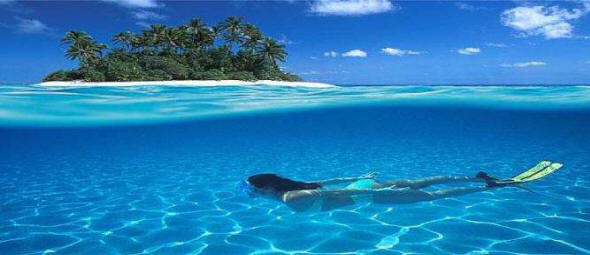Home › Diving › Lessons › Tips › Split-level Photography
Split-level Underwater Photography Techniques
Split-level photography is a 'split-shot' technique of producing amazing pictures that capture one image of air and water scenes simultaneously.
Over-under split-level photographs uniquely connect land lovers with ambassadors of the underwater world, accurately displaying the full picture both above and below the water level.
The viewfinder sees the full story as the topside subject continues its journey downwards under water.
Having perfected the technique, your gallery and portfolio improves with professional credibility and tremendous appreciation from fellow photographers.
Split-level photography requires optimum environmental conditions and some specialized camera equipment. An extra large camera dome and calm water is a bare minimum for getting the best split shots.
Add some imagination and some adventure and you are on your way to an exhilarating new technique of taking great combination photos.
Take time to plan a unique location and appropriately prepare for the unusual shot style. Your rewards are unparalleled with respect to normal underwater photography.
We advise testing your new skills at simple and easily accessible locations such as a home garden pond or calm freshwater stream before you try open water seas.
 It takes time and practice to become an expert.
It takes time and practice to become an expert.
Use your imagination and be creative when choosing your subjects.
Attempt to find a land backdrop with some character if you struggle to capture any amazing underwater creatures in the shot.
Consider the importance of the topside image as much as the shot below sea level.
Finding amazing underwater photos is not always possible.
Nonetheless, the top award winning split-level photographs are not always pictures of aquatic animals. Some of the most striking and stimulating split-level photographs are not coral reefs and sandy desert islands.
For example, we enjoy taking split-level shots in freshwater environments and we photographed unusual animals such as pigs, crocodiles, and birds halfway in and half out of the water with superb results.
6 Tips and Tricks for Superb Split-level Images
1. Use a Fisheye Lens in a Large Glass Dome Port
The ideal setup for split-level photography calls for a large glass dome with a fisheye lens. Large domes increase the underwater surface window. Using a mini-dome decreases the available area to get the water line in the correct position.
2. Use Small Apertures to Increase Your Depth of Field
In most split-level photographic projects, the distance of your focus point above the water line is further away than the underwater subject is. Using small apertures increases the likelihood of keeping everything in focus. Pushing up the ISO settings increases the aperture settings for darker conditions.
3. Choose the Optimum Time of Day and Water Conditions
Generally, you should expect the calmest water conditions in early mornings. The disadvantage of taking early daytime photographs is the lack of bright penetrating sunlight.
The sun at mid-day produces stronger light that penetrates deeper into the water. Small waves that often show later in the day creates some curvature and interest to the line halfway between air and water.
4. Shoot in Shallow Water
Natural sun light penetrates shallow water better than deep water. Shooting in low depths close to an island shoreline also allows you to get nearer to the top half subject.
Consider the tidal swings for reef scenes. Coral is likely to be nearer the surface at low tide. Be aware of your buoyancy for deep-water shots. Cameras and housings are heavy even those with flotation arms and most are negatively buoyant.
5. Photoshop and Graduation Filters
The image in the top half develops brighter than the bottom half. You can balance the exposure using a graduation filter or you can use a strobe in the underwater portion. An easier alternative might be to focus the image for the bright top section and then use Photoshop editing skills on the bottom half.
6. Keeping Water Droplets off the Dome
One of your biggest and most frustrating problems while taking photographs through water is water droplets settling on the dome lens.
There are two best solutions to reduce this. The most hygienic method is to apply an anti-fog spray or baby shampoo to the dome and then rinse it before you start taking your shots. Saliva is also effective if you do not have baby shampoo.
Split-level photography is all about thinking outside the box and producing natural images. By showing the aerial action and what is happening under water at the same time in one single image, your new creative style of photography is great fun and also available to non-divers.